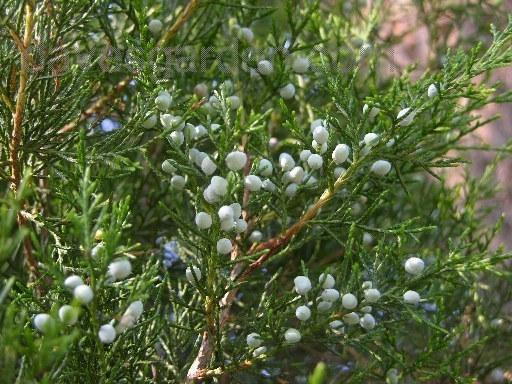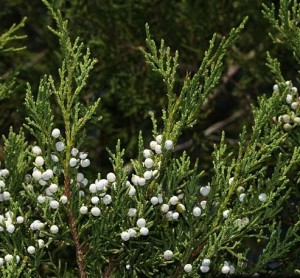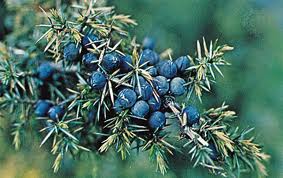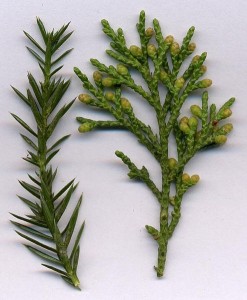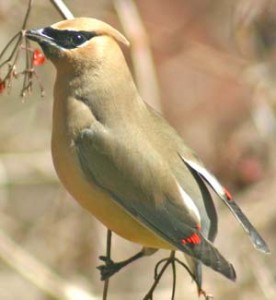In the cobweb recesses of my mind I have two memories of junipers. One was to make a tea to “force out” measles*. The other was how horribly prickly they were when someone shoved you into them.
As for “forcing out” measles that is highly doubtful. Measles make themselves known without having to be prodded to debut by any conifer tea. However junipers do have the potent antiviral compound deoxypodophyllotoxin (DPT) which has been shown to be effective against viruses that cause the flu and herpes. So maybe juniper tea did have some effect on the intensity or duration of the measles. The DPT is found in berries and the leaves, aka needles. I wonder if it is also in gin which is flavored with juniper.
Common in the eastern United States — officially east of the 100th meridian — is Juniperus virginiana, top photo, joo-NIP-er-us ver-jin-ee-AY-

J. sabina, often planted in North America as an ornamental, cannot be used either berries or leaves.
Besides medicinal uses, which includes treating diabetes, the berries are employed for flavoring, most notably in gin and the French liqueur Chartreuse. It takes the “berries” two to three years to ripen. Mature but still green berries are used to flavor gin. Mature blue berries are used to flavor game. They are also used to flavor stuffing, marinades and stews. In Europe one cannot make authentic sauerbraten or sauerkraut without juniper berries. In the southern Alps a dark syrup is made from the berries and is traditionally eaten as a dessert with cream or hot milk. (Some berries are as much as 30% sugar.)
As with many herbs used medicinally or as a spice juniper berries should be used sparingly. Think flavoring, not food. They irritate the kidneys and are diuretic. Juniper extracts should be avoided. They may be fatal. Florida’s Seminole Indians had many medical uses for the Easter Red Cedar. They used it to treat cold symptoms, swollen joints, stiff neck or back, swollen legs, eye diseases, fever, headache, dizziness and diarrhea.
The bush I was pushed into as a kid and pushed others into was J. communis, left, the most common juniper in northern latitudes around the world, joo-NIP-er-us koh-MUNE-iss. It’s also the juniper that flavors gin. There are 13 species of Juniper in North America, two in Europe, some say 19 in North America and maybe 60 in the world. Definitely used by native Americans were J. californica, J. communis, J. communis var. montana, J. deppeana [aka J. pachyphlaea] J. horizontalis, J. monosperma, J. occidentalis, J. osterosperma [aka J. utahensis] J. scopulorum, J. tetragona, J. virginiana and Juniperus silicicola, the latter often called a variation of J. viriginana.
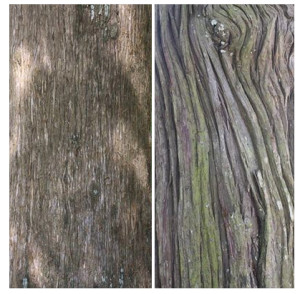
On the left is the bark of the red cedar (a Juniper) and on the right the bark of a white cedar, a Chamaecyparis thyoides
How the berries were used varied from tribe to tribe and species to species. The Acoma mixed the berries of the J. monosperma with chopped meat, put it into a clean deer stomach, then roasted it all. The Yavapai pulverized the berries of the J. deppeana, soaked them in water, put them in the mouth, sucked all the juice out, then spat out the solid matter. The Cahuilla dried the berries of the J. californica in the sun or ate them fresh. They also ground the berries into flour and used them to make mush or bread. The Diegueno considered the previous species berries as famine food only. But the Kawaiisu Indians deseeded the same berries, pounded the berries into a meal, moistened, molded the meal into cakes, dried them then ate them. The Paiute took the berries from the J. occidentals and mixed them with mashed deer liver for food. Or, they stored them in a grass-lined holes in the ground for winter use. The Apache boiled the berries of the J. osteosperma and ate them plain. But the Mescalero took J. monosperma berries, roasted them, added water, and made the mixture into a gravy.
Elsewhere the berries of these junipers have been use: J. tetragoan (Mexico) J. bermudiana (Bermuda) J. drupacea (Europe and Middle East) and in Asia J. chinensis, J. conferta, J. recurva and J. rigida.
One confusing element of identifying some junipers is that their juvenile leaves look different than their mature leaves, left. Young leaves of species like J. virginiana and J. chinensis are pointed, sharp even. Older leaves are overlapping and scale-like. Other junipers have only pointy leaves, hard and sharp. Some have a mixture of the two.
Juniperus comes from the Dead Latin iuniperus. Where that came from is not known but the best linguistic guess is iuncus meaning reed or rush. That might be related to an earlier Egyptian word ganu meaning reed, cane, shrub or bush. Iuniperus does NOT mean young — as in “junior” or evergreen. That is Wikipathetica nonsense. Iuniperus did get translated into Le genevrier in French from whence we get the word “gin.”
Gin was invented by Dutch physician Franciscus Sylvius, right, who wanted to make a diuretic medicine. He succeeded. In English the word “gin” first appeared in print in 1714. It was a very inexpensive alcoholic beverage to produce and became extremely popular. Alexander Pope in 1738 described it as “A spiritous liquor, the exorbitant use of which had almost destroyed the lowest rank of the People till it was restrained by an act of Parliament.” Actually Parliament passed Gin Acts in the 1730s and 1740s, which caused rioting. Everyone was swilling gin, kids to grannies, causing artist William Hogarth to engrave the print “Gin Lane” in 1751, below left.

Hogarth’s engraving Gin Lane show scenes of drunkeness and various illegal activities whereas his engraving of the same period, Beer Street, show happy, industrious people.
At one point of the 15,000 drinking places in London over half served only gin. More taxes and watering down the gin finally turned the alcoholic tide by the 1760s. The reason why gin took off was it was cheap, particularly compared to foreign booze that was charged tariffs. But there was also a cultural element. Beer was view positively and gin negatively. Hogarth’s other famous print, “Beer Street” shows positive scenes. The negative connotations of the time are still found in English with disparaging terms such as gin joint and gin mills.

Louisiana’s Cajuns are the descendants of French Canadians that were forcibly driven from Nova Scotia. Longfellows poem, Evangeline, gained cult then cultural status representing the inhumanity of their expulsion.
There’s one more bit of linguistic history regarding the J. virginana. The early French to Canada called it baton rouge, or red stick because the bark and wood have a red tint. When the Acadians were driven out of Nova Scotia and went to Louisiana to be come Cajuns — read Longfellow’s Poem, Evangeline — they found the Southern Cedar and named the capital of Louisiana for it, Baton Rouge.
To reiterate the berries of J. virginana and J. silicicola (Eastern Red Cedar and Southern Cedar) can be used but not the foliage. J. sabina and J. oxycedrus are to be avoided completely, berries and leaves.
As for wildlife the Cedar Waxwing likes the “berries” of the Eastern Red Cedar so much it was named after it. The J. virginiana also has one species of butterfly, the Juniper Hairstreak, that always lays it eggs only on the Eastern Red Cedar.
Bags can be made from the bark fiber of the Easter Red Cedar and the Southern Cedar.
* Did you know that measles might be a milder, human form of a fatal disease in animals? Researchers think measles came from distemper and jumped from dog to man about 4,000 years ago. Man befriended dog and dog gave him a disease. I had both kinds of measles when I was a kid, back to back, one right after the other. I was out of school for nearly a month… it was wonderful…

